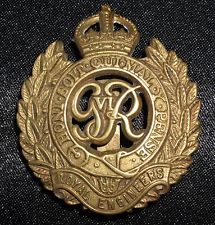
Ernest Charles Mundy

1st (Wessex) Field Company
Sapper 982
 |  | |
| Royal Engineers 1st (Wessex) Field Company Sapper 982 | ||
| Killed 26th July 1915 |
Ernest Mundy's Parents | ||
|
Ernest Charles Mundy was born in Bath in 1888, the second of six children born to Sidney Mundy and Sarah (nee Hale). Sidney MundySidney Mundy was born in 1863, the youngest of four children born to a family in the Shrewton area of Wiltshire. His mother and one of his brothers died while he was a young child and the 1871 census shows him in the Amesbury workhouse (aged 8) with his father and two remaining brothers, listed as ‘pauper inmates’. Ten years later, in 1881, Sidney was an apprentice to a carpenter in Wilton. | ||
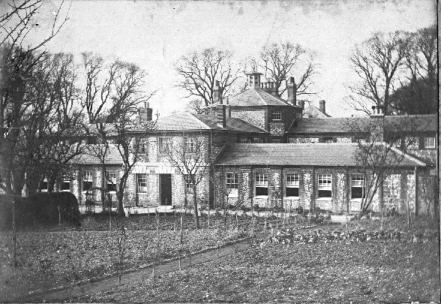 | ||
|
Amesbury Workhouse, where Ernest Mundy’s father lived for a time as a
child. [Image: www.workhouses.org] |
Sarah HaleErnest's mother, Sarah Hale, was born in 1864 in Bristol but by the age of 7 was living in Thorpe’s Buildings in Bath (Holloway area, cleared in the 1960s) as the adopted daughter of the Greenway family. The adoptive parents were aged 70 and 41 respectively and had a 20-year-old daughter of their own living at home. This appears to have been a relatively well-to-do family, with the father living from a pension and the daughter listed as having ‘no occupation’. In 1881, at the age of 17, Sarah Hale is listed as ‘visiting’ her adoptive family, but earning her living as a servant; one assumes she was working in another household, elsewhere, at the time. |
The Mundy Family |
|
We don’t know what brought Sidney to Bath, but he and Sarah married at the Register Office in Bath in 1885. The Bath Directory entries for 1886-7 show that they spent the first period of their marriage under the roof of the Greenways in Thorpe’s Buildings Sidney & Sarah produced six children: |
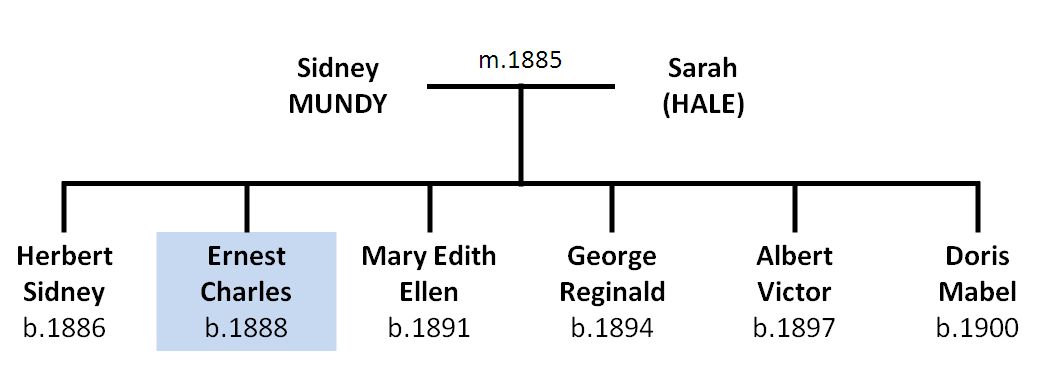 |
|
Herbert was born while Sidney & Sarah lived in Thorpe’s
buildings. Ernest Charles
was born in 1888, shortly after the family’s move to 5 Victoria Terrace (off
the top of Brougham Hayes), where they lived for around three years. In this
time, Sidney (father) features in a number of newspaper articles relating to
minor matters before the magistrates court. Firstly, he was charged with having
stolen a plank of wood from a timber yard, but charges were dropped when it
became clear that he was simply following his employer’s instructions, on the
assumption that his employer had some prior understanding with the timber
merchant. In the second case, Sidney Mundy was the aggrieved party, as a
neighbour’s son had knocked over a pile of timber in his garden. |
|
5 Victoria Terrace, home of the Mundy family at the time Ernest was born. |
|
Thirdly, Sidney Mundy made the news in connection with a 'heated debate' with a neighbour:
In 1891 the family moved to West Avenue. They lived at
number 5 (next door to the author’s Great-Grandfather
Joseph Nixey!) until 1893 (Mary would probably have been born here) and
then at number 39 in the years 1894-1900, during which time George, Albert
('Vic') & Doris were born. Ernest’s
schooldays would have been about 1893-1900, so he would have spent the
majority
of his time at South Twerton School walking from 39 West Avenue. Sidney
was
still working as a carpenter throughout this period and we know from a
brief mention in a 1901 court case (where Sidney appeared as witness)
that he was employed by a Mr James Neal Gould, possibly in Bathwick. |
|
Numbers 5 (L) and 39 (R) West Avenue |
|
The 1901 census shows the family living briefly at 31
Herbert Road (two doors from the author’s Great-Grandfather Thomas W Branston!). Around this time, Ernest was in a
minor scrape with the law, being one of four lads fined 5 shillings for
‘obstructing the highway’ in Twerton. September 1901 was also memorable for eldest son Herbert
Sidney (age 15) who was seen stealing ‘2d worth of walnuts’ from the rear of
Wentworth House (now a Bed & Breakfast) in Bloomfield Road together with
John Rutter of Maybrick Road. A policeman ‘chased them down the railway line’
(now the Linear Park) and caught the miscreants. Each was fined 2s 6d. The family moved to 49 St Kilda’s Road in the same year. 49 St Kilda's Road We know that Herbert and Ernest attended evening school at
South Twerton in the years immediately following the end of their daytime
education. South Twerton seems to have provided a strong and well-attended
programme of practical educational classes covering handicrafts and technical
subjects. The prize-giving evenings were reported in the press, with prizes
suited to the subjects studied; In 1904, for example, Herbert was presented
with a panel saw and Ernest with a writing case. Sadly, we only know a few further details of Ernest’s life in the ten years
before the outbreak of war, We have been fortunate to trace and meet a living relative of Ernest Mundy, namely Mr Keith Jones, who is the son of Ernest's younger sister Doris. He was able to tell us that the reason that Mary was missing from the household in the 1911 census was that she had gone to live in Australia. Shortly afterwards, Mary & Ernest's father Sidney Mundy also went to Australia and began to make plans to sell numbers 49 and 46 St Kilda's Road (both of which he owned) in order to facilitate his emigration. After one of the house sales fell through, he returned to Bath to sort matters out, but was interrupted by the outbreak of the war in 1914. The story in the family is that he joined up and went to France. He would have been 51 in 1914, but the photograph below does indeed seem to show Sidney Mundy in WW1-era uniform and looking all of 50 years old!  Sidney Mundy; Ernest's father [photo courtesy of Keith Jones] As for Ernest, Keith Jones was able to show us various documents and photographs from Ernest's pre-war life, including his Post Office savings book, showing that Ernest had saved around £5 prior to joining up. Entries and stamps were those of Moorfields Post Office in Moorland Road (which only recently closed).  |
Ernest Mundy in WW1 | ||
Territorial in the Wessex Field Company of the Royal Engineers
At the outbreak of war in August 1914, Ernest was a Territorial (part-time) member of the Wessex Royal Engineers. On Tuesday August 4th, Ernest was completing a training camp with the Royal Engineers which had taken place on that Bank Holiday weekend, such as were regularly held to practice various aspects of their specialist services. On the weekend in question, the unit had been on Bulford Down on Salisbury Plain. With some suddenness, they found themselves involved in the mobilisation for war and they returned to Bath only briefly on Wednesday 5th before setting off for active service the same evening. They were allowed to spend just a few hours at home. This photograph of Ernest in his Royal Engineers uniform survives in the family album: 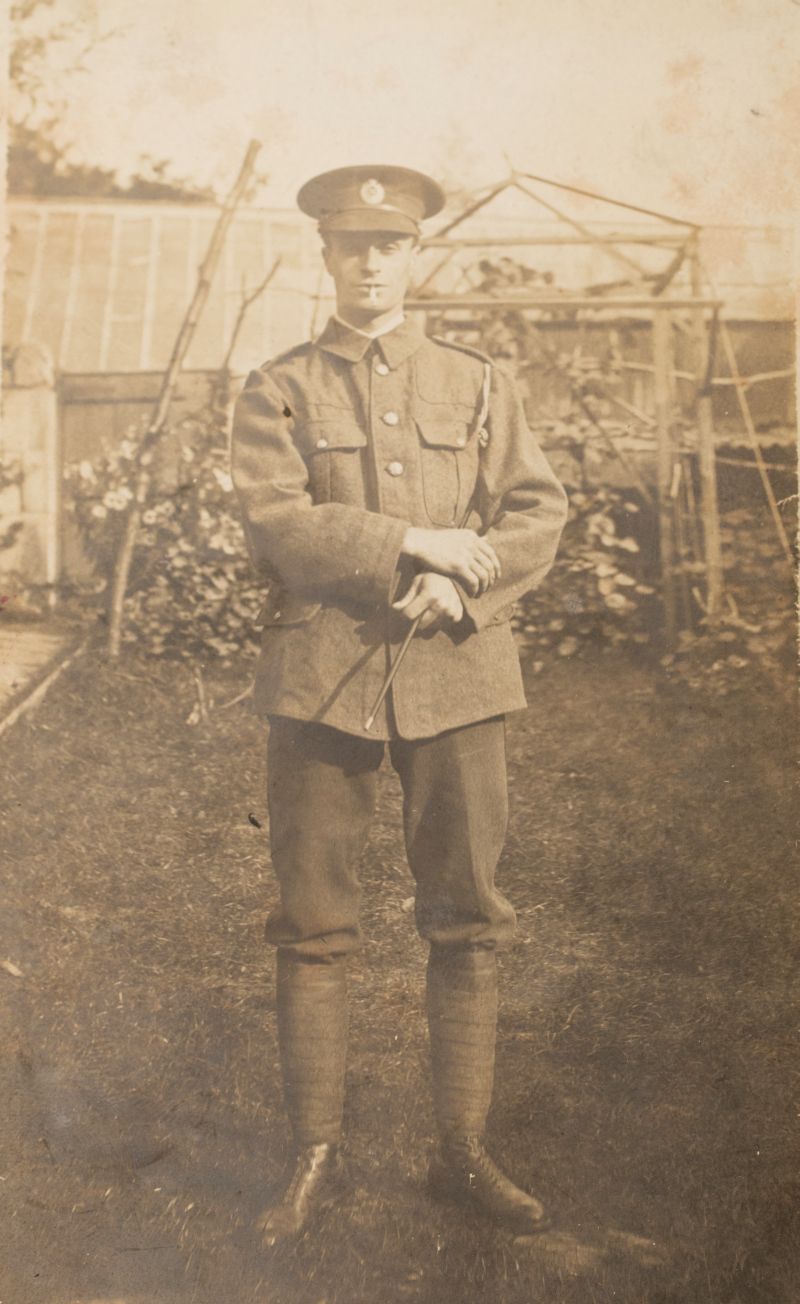 Ernest Mundy in Bath, probably before leaving for France [photo courtesy of Keith Jones] | ||
|
Bath Chronicle and Weekly Gazette - 8 August 1914 THE BATH ENGINEERS The 1st Field Company of the Wessex Royal Engineers returned to Bath from Bulford Camp on Wednesday (5th August), and left for their war station in the evening. They had had a very trying time. One of them remarked to a friend that it had taken them 24 hours to get from the Plain. Later enquiries elicited that they left Bulford at half-past four, but it appears that they had been on the station there since Tuesday morning. The men looked dog tired and some of them said they had not slept for two or three nights. To crown it all, Tuesday night was the wettest and most dismal which even old campaigners had ever experienced. Even when they arrived in Bath, their great coats were still soaked through, and some of the men said the water had been ankle deep. At the Bath station, the band was drawn up at the foot of the goods slope, whilst the wagons loaded the baggage for the depot. Major Dutton was present. A large crowd took interest in watching the men march down and the limbers and wagons brought into Dorchester Street. The men snatched a few brief hours of home comfort before they re-assembled at the depot to march to the station. The men, 113 in number, paraded at the Drill Hall, Upper Bristol Road, shortly before six. The officers who accompanied the men were Major Dutton, Capt. Harvey and Lieut Pitt. Lieut. Harbutt, with an advance party, left earlier in the day to take over stores. The streets through which the men passed on their way to the station were lined by interested spectators and the approach of the contingent to the G.W.R. station was signalled by loud cheering. The entraining of the men was witnessed by hundreds of people. The train in which the men left was drawn by an engine upon which was affixed a card inscribed, "AB3S." At 6.40 the train steamed out of the station amid cheers and the waving of hats and handkerchiefs. The mounted men leave on Saturday with wagons and stores and the headquarters will then be made a depot for enlisting recruits. The men who were mobilised on Wednesday received their bounty of £5 per man. |
Ernest's Brother: Albert 'Vic' MundyIn September 1914 the Bath newspaper began to publish lists of those who were heeding the call to join up. On 26th September a list of businesses was published, with names of staff from each company who had enlisted. This was designed to bring credit upon those businesses and pave the way for other companies to follow suit. In this context, Ernest’s brother Victor was listed as having joined up from the company of H.F. Head of Stall Street.He served with the 4th Somersets (serial number 200878) in India; the 4th Battalion went to India to replace the 1st Battalion; the experienced 'regular' soldiers of 1st SLI were needed at the front in France. Vic eventually rose to the rank of sergeant. Here he is as yet without his stripes. 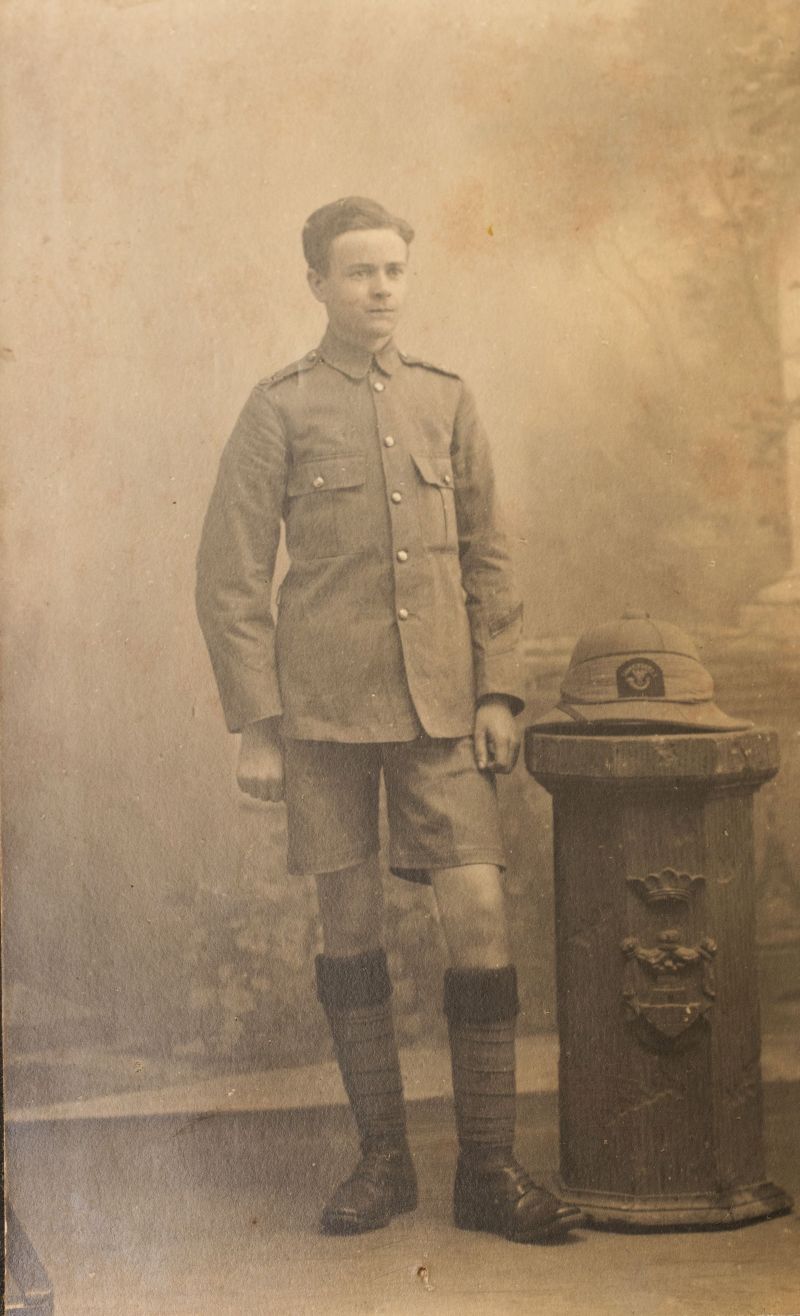 Victor (brother) in shorts befitting his posting to India with the 4th Somerset Light Infantry (the badge of the S.L.I. is clearly visible on the pith helmet). [photo courtesy of Keith Jones] |
Ernest in the Wessex RE: Regular Soldiers and Service Abroad
The newspaper of 8th August 1914 also reported that the mounted section of the 1st Wessex RE was due to leave Bath that same evening (8th August). A month or so later, on 12th September it was reported that the entire company had volunteered for service abroad, to which their terms of service as Territorials did not oblige them. |
|
Bath Chronicle and Weekly Gazette - 28 November 1914 1st WESSEX ROYAL ENGINEERS TERRITORIALS NO LONGER Signal compliment has been paid to the 1st Field Co., which is composed
of Bathonians, by the military authorities. It was announced to the Company by
the Major in command on Tuesday that they had been transformed into Royal
Engineers. Practical effect has been given to this honour by the removal of the
brass letter 'T' from their shoulder straps. They have been placed in one of the
finest divisions in the British Army. This evidence of appreciation by the
powers that be has caused great rejoicing in the corps. They are expected to be
dispatched upon war service very soon. |
 |
|
A photograph of the 1st Battalion (Wessex) Royal Engineers
featuring Sapper Ernest Mundy (3rd from left, back row) and also
Sapper Ernest West (3rd from left, 3rd row from top).
[Image: Bath Chronicle & Weekly Gazette, 2nd January 1915.] |
|
The company
was attached to 27th Division which organised in England in
November-December 1914, largely from Regular units recalled from overseas
(mainly India), and landed in France on Christmas morning in 1914. Owing to the fact that the company was largely formed of
Bathonians, individual items from the local newspaper over the next few months
give a taste of some of the details of what the company experienced: |
|
Bath Chronicle and Weekly Gazette - 2 January 1915 NEWS OF THE WESSEX ENGINEERS ARRIVAL NEAR THE FIRING LINE LETTER FROM A BATH SERGEANT Bath Chronicle and Weekly Gazette - 14 January 1915 WESSEX ROYAL ENGINEERS AT THE FRONT Sapper N. V. H. Symons, a son of
the headmaster of King Edward’s School, Bath, in a letter from the front dated
the 6th inst., makes it evident that the 1st Wessex Engineers—composed almost
entirely of Bath and Weston-super-Mare men—are now in the firing line. He says
they marched from their farm billet on Tuesday, the 5th inst,, from 8.30 a.m.
to 3 p.m., and it was such severe marching that when the destination was
reached only about six of 40 in Sapper Symon's section were left. He adds,
‘Today we have covered 10-11 miles of cobbles and most of us are absolutely
dead lame. We are now in the thick of it, and shells are literally bursting all
around us." Bath Chronicle and Weekly Gazette - 20 February 1915 A WESSEX ENGINEER HOME Bath Chronicle & Weekly Gazette - 10
April 1915 FOOTBALL AT THE FRONT Bath Chronicle & Weekly Gazette - 17 April 1915 MEETING THE WESSEX R.E. A Bath soldier in a Line regiment, writing from "somewhere in Belgium," under date April 9, says: "I glad be able to say that I have met the whole Company of Wessex Engineers from Bath, including Sergt. Cass. Ben Hurst, Fletcher, Ulrico, Francis Webber, Young. Sainsbury, Nixey, Bristow, Bishop, Hemmings, Loader, etc., and they are all looking well. Bath Chronicle & Weekly Gazette - 19 June 1915 THE WESSEX AT YPRES INTERVIEW WITH WOUNDED BATH SAPPER. FIRST EXPERIENCE OF POISON SHELLS Sapper John H. C. Pearce, of the Wessex R.E., one of the gallant band of Messrs. Stothert and Pitt’s workmen who have given up all to answer the nation's call, has just returned wounded to his home in Combe Hill, more generally, perhaps, known as Brassknocker Hill, Monkton Combe. There he was interviewed by a representative of the “ Chronicle”' and his story sheds a little more light on the brave exploits of the Wessex Engineers, and their onerous and distinguished part in the greatest war of all time. Pearce has come from Ypres, an ill-fated city around which the interest of everybody has long centred. For Ypres is an important key, the Germans want it badly, yet, in spite of the fiercest attacks of their artillery, the English have held it. Pearce had served five years in the first company of the Engineers, and had left it about 12 months, when the war broke out. Four days afterwards he left his job as a fitter at Messrs. Stothert and Pitt's, and rejoined the Engineers, being put in the 2nd Company. For a while was on the depot staff, Upper Bristol Road, but in December he crossed the sea with the 27th Division from Winchester, and ate his Christmas dinner in France. The first serious engagement in which he participated was in February, when the Germans broke through for the first time at St. Eloi. There they lost Captain Wills, Lieut. White and Lieut. Carr. Lieut. Carr was in the trench when the German attack was made, in which the Leinster Regiment were so badly cut up. The other officers having been killed, Lieut. Carr remained in charge of the infantry until he, too, was killed as the attack proceeded. That was on Sunday afternoon, Valentine's Day, February 14th. Next morning Captain Wills was killed just after the trench had been recaptured by the K.R.R. [King’s Royal Rifles], and the D.C.L.I. [Duke of Cornwall’s Light Infantry] Evidences of the ferocity of the Germans were numerous and too terrible to print. Two German prisoners captured in that part of the trench were mere lads of sixteen years of age. One, who could speak English fluently, told his captors that his father was interned in England. FIRST EXPERIENCE OF POISON GAS The first use of poisonous gas by the Germans best described in Pearce's own words: I well remember my first experience of gas, on the left of Hill 60. We were erecting barbed wire entanglements—a section of us, under Corpl. Weekes, who was formerly in the service of Mr. Hague, optician, Broad Street, Bath. We had been there about half an hour, I suppose; and had just finished driving in the stakes before starting wiring, when we began to notice an awful smell. It began to affect our eyes, and we could not understand it at all. For some time we thought it must be due to the resin in the wood which we were using, and then someone suggested that it might proceed from the shells that were going over. This idea, I must say, was at first laughed at as being ridiculous, but we soon had to quit the spot, the gas affecting our eyes and throats so distressingly. Corpl. Weekes, finding that the situation was getting too serious, ordered us to fall back. That was the first time the Germans had made use of this style of warfare, and we were unprepared with any means of counteracting its effects course we had no respirators then. YPRES—THEN AND NOW I cannot tell how long we were in Ypres, but it was some considerable time. St. Eloi is not very far away. When we first went into and looked around, we thought what nice place it was. The last time I came through it was by night, and the place was all in flames. It was a terrible sight—a big red glow against the sky. But our first the town was practically deserted the populace. Everything was left, eatables of all descriptions, also bedding and furniture. It was a cruel sight to enter the houses, and see all the furniture, fine carpets, and everything abandoned by the owners, who had been glad to escape with their Iives. Of course we were in comfort, and wanted for nothing. In the casemates we had six wounded with us; two of these died, and we had to bury them; the others were taken away by motor ambulance. The Germans left two churches with spires standing, and these, we found, served their artillery as an excellent guide. I understand that, since I was wounded, one of those churches has been blown down by our own men to remove a landmark which was a great help the enemy, and a corresponding danger to ourselves. GUARDING THE BRIDGES While we were in Ypres we were very safe in the casemates. The enemy were firing from three sides, but could not touch us. Some shells pitched into the back of the bank, but owing to the great thickness of earth no harm came of them. There was a thickness of between thirty and forty feet of earth to protect us. When our company left the casemates, ten men remained behind to keep the road clear for the transport service. There were two bridges, something like the old bridge Bath, one at each side of the town, and there was also a. pontoon bridge over the moat to be guarded. One of bridges was the special object of the enemy's attention. They had got the exact range, and shelled with shrapnel all day long. Every time a shell pitched upon that bridge, and caused any obstruction, had go out and clear it away very quickly, in order that supplies of ammunition could be kept going steadily and regularly forward. At length, our ten of the 2nd Company were relieved by ten of the 1st Company, and we rejoined our company by going up to the dug-outs in the wood near the chateau on the Hooge road. We remained several days in those dug-outs about 200 yards behind the firing line. Then, whilst digging a gun emplacement one day, we had one man killed and four wounded by the same shell. The dead man came from Bridgwater way: one of the wounded was Pioneer Kendall, of Bath. Shortly afterwards, two sections of us were moved back for a rest, the other two sections relieving us. We were called up, however, the first night, and were marched about six miles up the line, to almost where we were before, I suppose. A SHOT FROM A SNIPER "It was whilst making entanglements I received a shot from a sniper. The bullet caught me in the back somewhere near the kidney, travelled across and through the body, and made its exit from my left breast. I did not feel very much pain from it, nor did the wounds bleed much. It was a very neat clean wound, the point of exit was no bigger than the point where the bullet entered, showing that the bullet had not been tampered with, and had not mushroomed. Consequently everything was in a straightforward way for healing from the first. I was taken, without any intermediate stage, to the base hospital. No. 13 stationary hospital on the docks at Boulogne, and I only remained there one day, when I was taken aboard the Asturias, bound for England. I have been in England four weeks to-day (Saturday), so that it can only have been a day or two over the four weeks since I received my wound. I do not feel much of it now, unless I do any lifting or stooping, and then realise that all is not yet quite as it should be. I suppose the damage caused by the bullet as it passed through the various muscles and parts my body will take some time to get all right and sound. It is pleasant to think that Ypres, where we were stationed so long, is a position of so much importance, danger, and therefore of honour. Our Brigade, the 80th, was praised up by Sir John French in one his despatches the other day, and in that praise, of course, the Wessex come in for a share. The peculiarity of the position was best seen at night time, when the Germans sent their star shells. Then it was that seen that they lay round us in a sort of horseshoe formation; and, that is one reason, no doubt, why our advance has not been pushed in that direction. In fact we retreated a little from the toe of the horse-shoe, as far as the chateau on the Hooge road, so as to strengthen our position by straightening our line a little," From Bath Chronicle & Weekly Gazette - 10th July 1915 SAPPER JOHN H. C. PEARCE BATH SAPPER COMMENDED Sapper B. W.- Pearce, of 42, St. John's Road, Lower Weston, has been with the 1st Wessex R.E. " somewhere in France " since December. He and his comrades have been kept busy digging trenches, dug-outs and making huts etc. In spite of plenty of hard work and hardship, he is still in the best of health, and hopes shortly to obtain a few days' leave. We are pleased to say he has received a card of special mention. Sapper Pearce, before he enlisted in September last, was in the office of Messrs. Duck, Son and Pinker (Ltd.), Bath. |
Ernest Mundy's Death | ||
| Sapper Ernest Mundy was killed in action on 26th July 1915 at Armentieres We don't currently have any more details of the Wessex RE's exact movements on that day, but the history handed down in the family is that Ernest was killed by sniper fire, a perennial danger for anyone at the front, whether in trenches or support lines. | ||
 | ||
|
The announcement in the Bath Weekly Chronicle
& Gazette of Ernest Mundy’s death. |
Ernest's Will
Ernest's nephew Keith was able to show us a transcript of Ernest's will, which contained some intriguing information. He left £10 to a Miss J. Crouch of 13 First Avenue and the remainder to his mother. The inference is that Miss Crouch was a sweetheart; perhaps even a fiancée.
Indeed, one of the family photographs of Ernest in uniform in Bath (before his departure for the war) shows him seated with a young woman who could easily have been the Miss Crouch in question, as she is not a member of the family:
For women who lost loved ones in the war, commemorative 'mourning' brooches were made. This is a picture of one such that was specific to the Royal Engineers:
|
Burial | ||
ArmentieresErnest was originally buried in Armentieres and this most amazing photo of his original grave is in the possession of the family: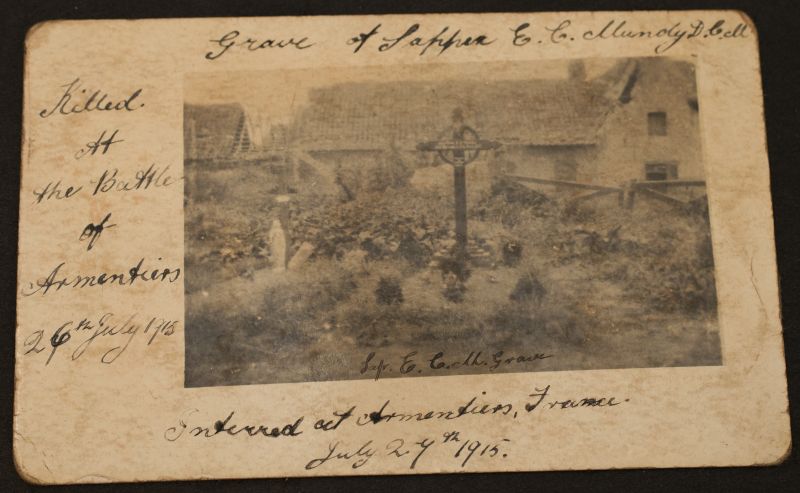
** Battles have been re-defined and re-named over time, but the action now known as the Battle of Armentieres took place in October 1914. In fact the Armentieres sector is supposed to have been relatively quiet in July 1915. Ration FarmErnest was re-buried (presumably after the Armistice in 1918) at Ration Farm Military Cemetery, La
chapelle d’amentieres, France. The cemetery is about 10 miles NW of Lille in
France and has over 1,300 graves of fallen soldiers. | ||
|
Ration Farm Cemetery |
|
For much of the war, Ration Farm was just over 1 kilometre behind the front line at the end of a communication trench. The first cemetery, Ration Farm Old Military Cemetery, was begun in February 1915, close beside the farm buildings. It was used until October 1915 chiefly by units of the 6th Division and at the Armistice it contained 73 graves. The present cemetery was begun (as Ration Farm New Military Cemetery) in October 1915 and remained in use until October 1918. It was very greatly increased after the Armistice when graves were brought in from isolated sites and small cemeteries on the battlefield. Among the isolated graves brought in were many of Australian soldiers who died in the Attack at Fromelles on 19 July 1916. There are now 1,313 Commonwealth servicemen of the First World War buried or commemorated in the cemetery. 677 of the burials are unidentified. [Source: Commonwealth War Graves Commission] In June 2019, Ration Farm Cemetery was visited by Mike Sumsion of Bath, who has taken an active interest in this project to commemorate the fallen servicemen of Oldfield Park Junior School. He took with him a memorial cross from the school, inscribed by a pupil, to place on the grave as a symbol of ongoing remembrance. We are grateful to Mike for his support for the school project and for providing the photographs below:  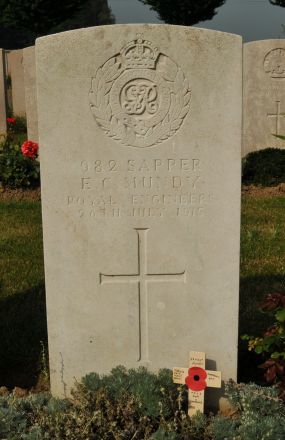 |
Decoration | ||
|
Although his medal card does not survive, Ernest Mundy would have been posthumously
awarded the 1914-15 Star (awarded to soldiers who fought before the end of
1915), the British War Medal 1914-18 and the Allied Victory Medal. | ||
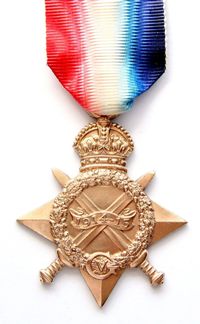 |  | 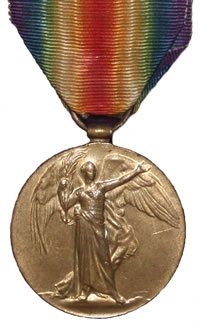 | ||
| 1914-15 Star | British War Medal 1914-18 | Allied Victory Medal |
Commemoration | ||
 In addition to his commemoration on the South Twerton School memorial, Sapper Ernest Mundy is commemorated as follows: | ||
|
Bath War Memorial See separate page for details of the Bath War Memorial. Ernest Mundy's inscription: |
 |
|
Ascension Church Memorial Ernest's name is inscribed on the oak tablet in the Ascension Church (see separate page for details of the Ascension Church Memorial), albeit with a mis-spelling of his surname: |
 |
|
Moravian Church Memorial Ernest's name is inscribed on the Moravian Church tablet, now in the Ascension Church (see separate page for details of the Moravian Church Memorial): |
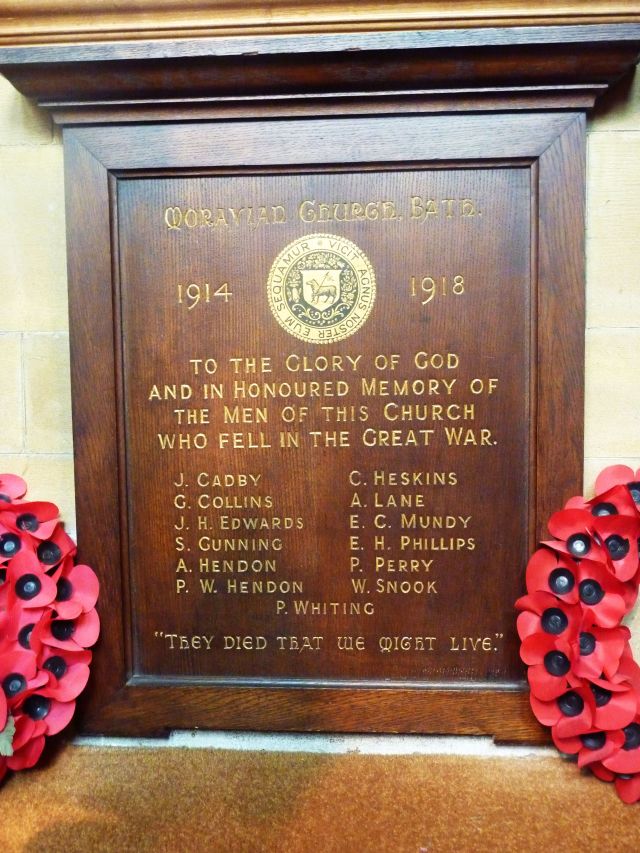 |
|
Wessex Royal Engineers Memorial, Bath Abbey In Bath Abbey there is a plaque - without names - to commemorate the Bath men who gave their lives in service with the Wessex Royal Engineers. Sadly, Bath Abbey is currently doing a poor job of honouring the memory of the fallen soldiers of WW1. They hosted a wonderful Vigil service on 4th August 2014, but key artefacts are not properly accessible, despite this having been brought to their attention. This plaque is one such. Instead of being on display as it should be, the Wessex RE plaque is behind a locked wooden screen in the North transept. If you wish to view the memorial, try to access the Abbey when an organist is performing or rehearsing and you may be lucky enough to find the screen unocked. Then you just have to fight your way past the stacked chairs... It really is inappropriate and very sad. |
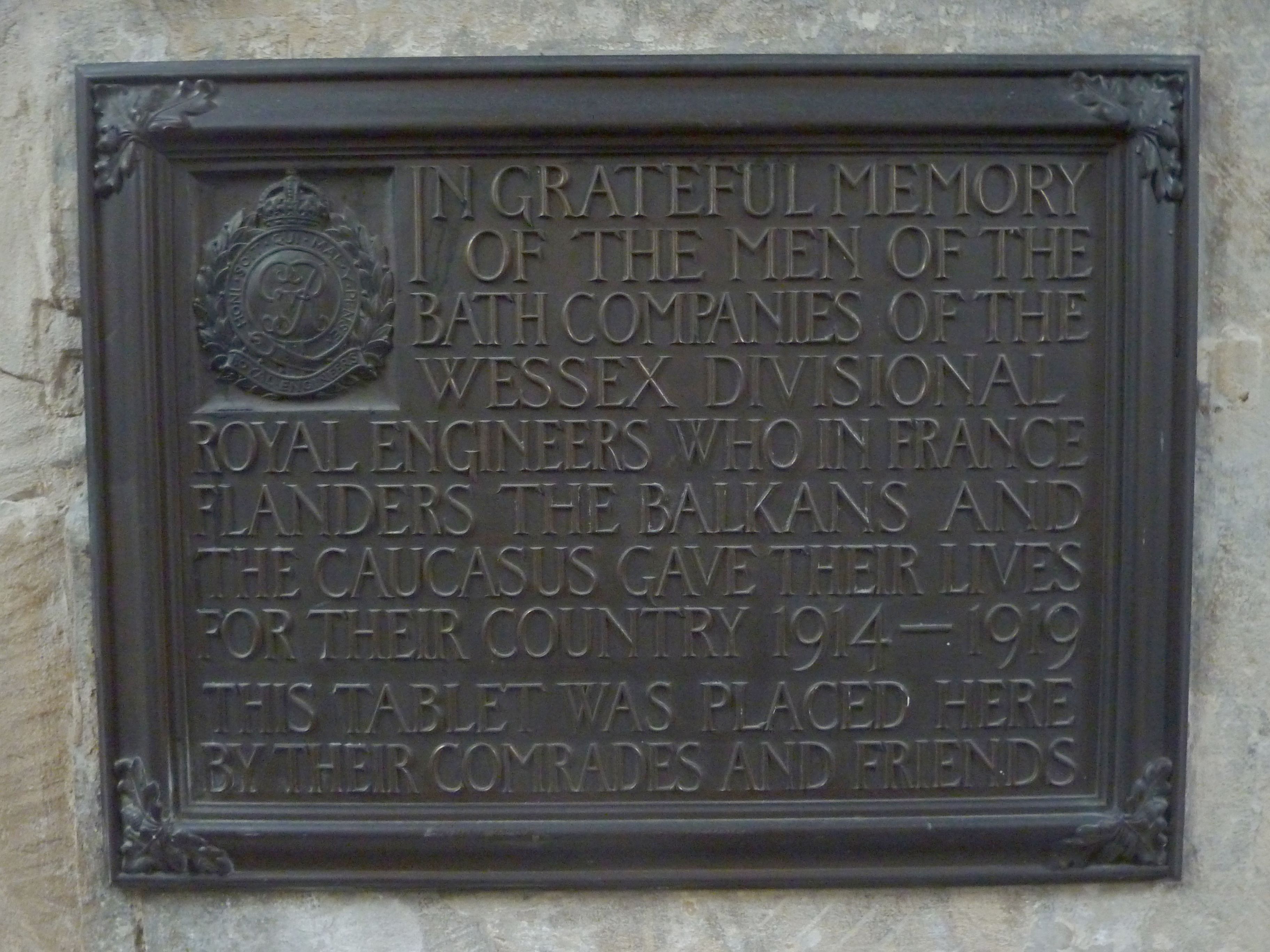 |
| 'Death Penny' The family also has in its possession the Memorial Plaque and accompanying message from the King that was sent to the family of each British casualty of WW1. The plaque is inscribed with the name of Ernest Charles Mundy. |
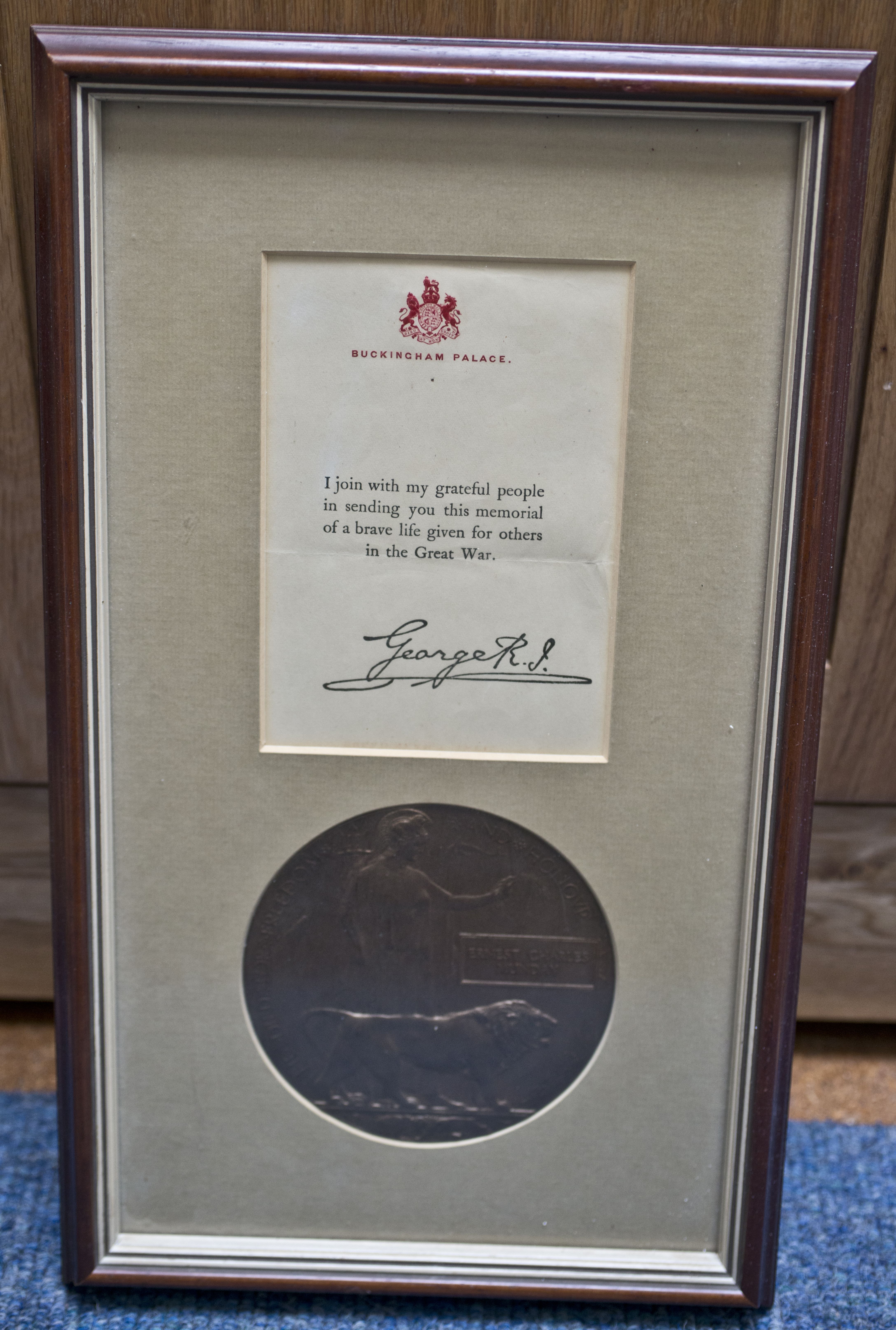 |
Further Information |
Albert 'Vic' MundyErnest's
brother Vic survived the war. Here is a photograph of an older, altogether more
careworn soldier than we saw in the photograph of Private Vic Mundy,
above. He also sports his Sergeant's stripes and a marksman's badge: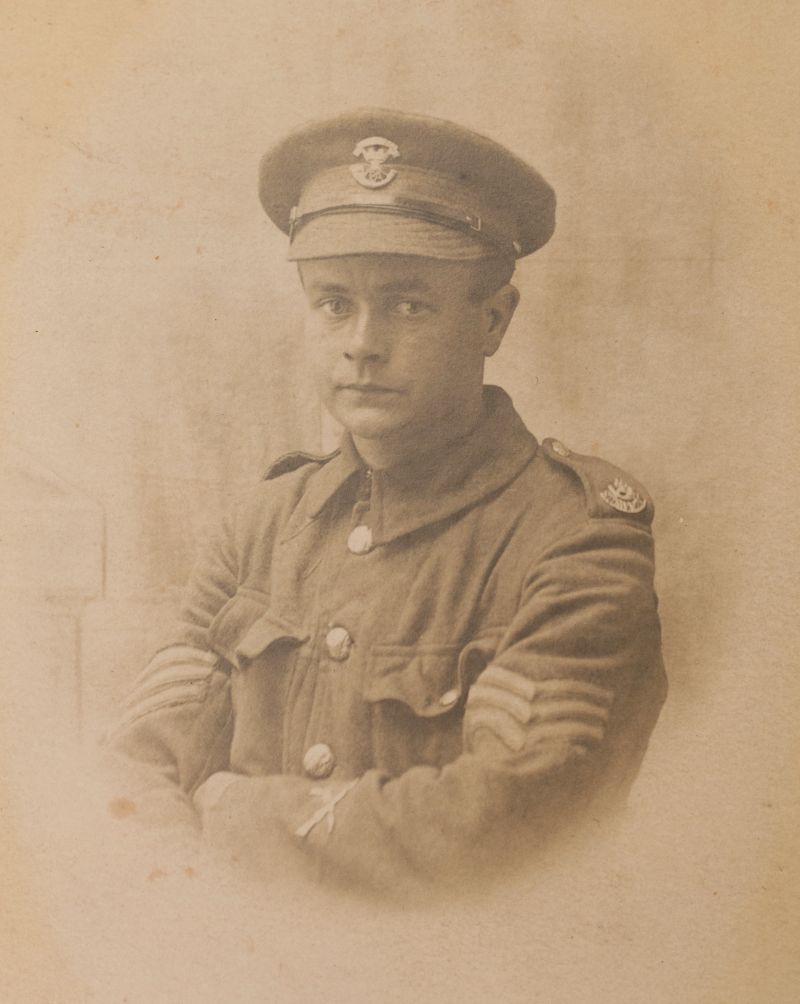 [photo courtesy of Keith Jones] Living relativesIt has been great to meet with Mr Keith Jones and his family. Owing to the fact that Keith's mother (nee Doris Mundy) was much younger than Ernest, Keith is Ernest's nephew; no 'greats' involved! It was wonderful to welcome Keith to the exhibition held at Oldfield Park Junior School in July 2015.
As well as providing much of the information and many of the photographs on this page, Keith is also a former employee of the Bath Press and has been instrumental in locating the missing Pitman Press memorial and bringing it back to Bath. It would be great to hear from any other living relatives of Ernest Mundy. We know that:
Please get in touch!If you have any further information on Ernest Mundy, or want to suggest corrections / improvements for this page, please use the Contact page to get in touch. |